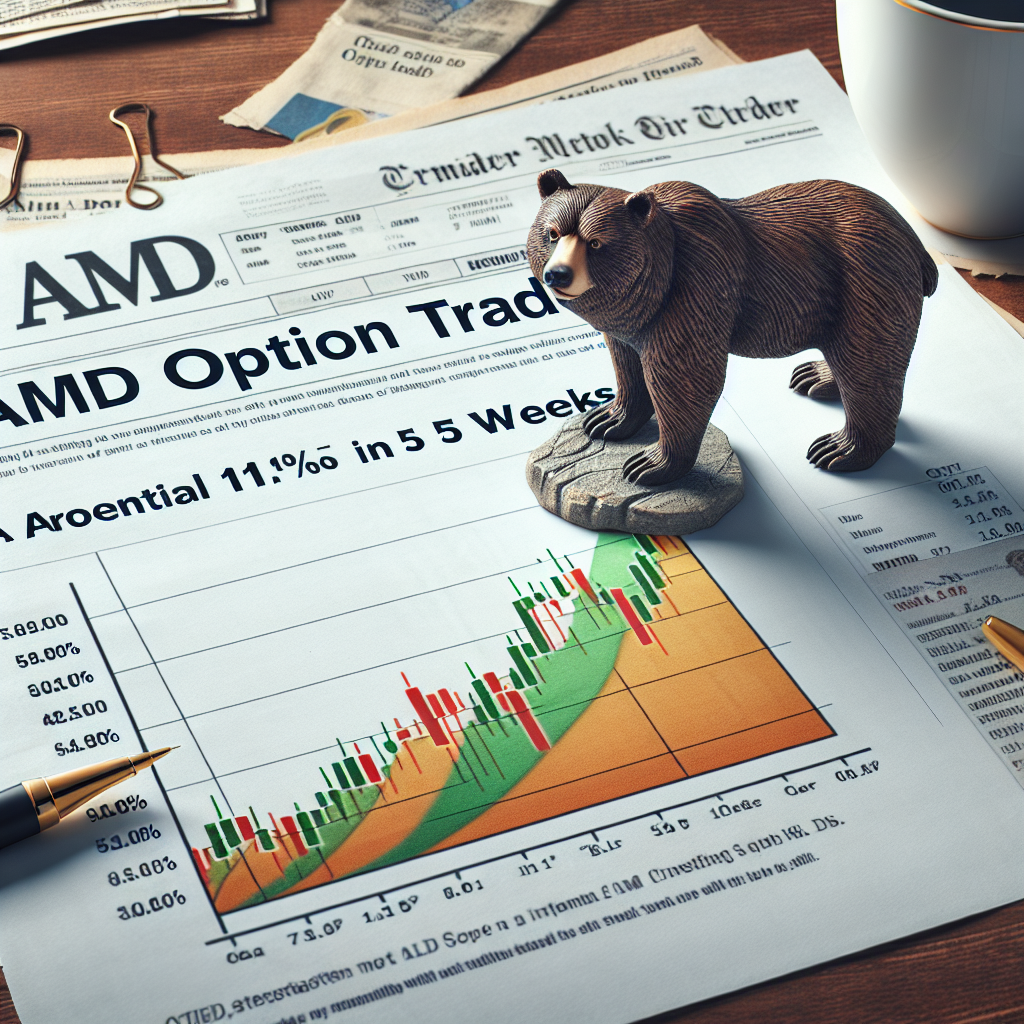“Unlock an 11% Gain in Just 5 Weeks: Navigate the Bearish AMD Option Trade!”
Introduction
Investors seeking short-term opportunities in the options market may find a compelling case with a bearish strategy on Advanced Micro Devices (AMD). With the semiconductor industry facing potential headwinds, a well-timed options trade could yield significant returns. This strategy involves leveraging put options to capitalize on anticipated downward price movements in AMD’s stock over a five-week period. By carefully structuring the trade, investors can potentially achieve an 11% return, making it an attractive proposition for those with a bearish outlook on the stock. This approach requires a keen understanding of market dynamics and risk management, but for those willing to navigate the complexities, it offers a promising opportunity to enhance portfolio performance in a relatively short timeframe.
Understanding Bearish Option Strategies: A Deep Dive into AMD Trades
In the realm of financial markets, options trading offers a versatile approach to capitalizing on market movements, whether bullish or bearish. One such opportunity lies in the potential for an 11% return in just five weeks through a bearish option trade on Advanced Micro Devices (AMD). Understanding the intricacies of bearish option strategies is crucial for investors seeking to profit from anticipated declines in stock prices. This article delves into the mechanics of such strategies, using AMD as a case study to illustrate the potential for significant returns.
To begin with, bearish option strategies are designed to profit from a decline in the underlying asset’s price. These strategies can be particularly appealing in volatile markets or when specific stocks are expected to underperform. In the case of AMD, a leading semiconductor company, various factors such as market competition, supply chain disruptions, or broader economic conditions might lead investors to anticipate a short-term decline in its stock price. By employing a bearish option strategy, traders can potentially capitalize on this anticipated downturn.
One common bearish option strategy is the purchase of put options. A put option gives the holder the right, but not the obligation, to sell a specified amount of an underlying asset at a predetermined price within a set timeframe. If the price of AMD’s stock falls below the strike price of the put option before expiration, the trader can exercise the option to sell the stock at the higher strike price, thereby realizing a profit. Alternatively, the trader can sell the put option itself at a higher premium, reflecting the increased likelihood of the option being in-the-money.
Another approach is the implementation of a bear put spread, which involves buying a put option at a higher strike price while simultaneously selling another put option at a lower strike price. This strategy limits both potential gains and losses, making it a more conservative choice for traders. The maximum profit is achieved if AMD’s stock price falls below the lower strike price at expiration, while the maximum loss is limited to the net premium paid for the spread.
Transitioning to the specifics of the potential 11% return in five weeks, traders might consider the current market conditions and AMD’s stock performance. By analyzing technical indicators, earnings reports, and industry trends, traders can make informed decisions about the likelihood of a price decline. If the analysis suggests a bearish outlook, executing a bear put spread with carefully selected strike prices and expiration dates could yield the desired return.
Moreover, it is essential to consider the risks associated with bearish option strategies. Market conditions can change rapidly, and unexpected positive developments for AMD could lead to losses. Therefore, traders should employ risk management techniques, such as setting stop-loss orders or diversifying their portfolios, to mitigate potential downsides.
In conclusion, bearish option strategies offer a compelling avenue for traders seeking to profit from anticipated declines in stock prices. By understanding the mechanics of these strategies and conducting thorough market analysis, investors can potentially achieve significant returns, such as the 11% return in five weeks with a bearish AMD option trade. As with any investment strategy, careful consideration of risks and market conditions is paramount to success.
Maximizing Short-Term Gains: How to Achieve an 11% Return in 5 Weeks
In the ever-evolving landscape of financial markets, investors are constantly on the lookout for strategies that can yield substantial returns in a short period. One such opportunity lies in the realm of options trading, where a well-timed bearish trade on Advanced Micro Devices (AMD) could potentially offer an 11% return in just five weeks. This approach, while promising, requires a keen understanding of market dynamics, risk management, and the specific mechanics of options trading.
To begin with, it is essential to understand the current market sentiment surrounding AMD. As a leading player in the semiconductor industry, AMD’s stock performance is often influenced by broader market trends, technological advancements, and competitive pressures. Recently, there has been a growing concern about potential overvaluation in the tech sector, coupled with supply chain disruptions that could impact production and sales. These factors contribute to a bearish outlook on AMD, making it a suitable candidate for a short-term options trade.
The strategy in focus involves the use of put options, which are financial instruments that give the holder the right, but not the obligation, to sell a stock at a predetermined price before a specified expiration date. By purchasing put options on AMD, an investor can profit from a decline in the stock’s price. The key to maximizing returns lies in selecting the appropriate strike price and expiration date, which in this case, is set five weeks from the trade’s initiation.
Moreover, timing is crucial in options trading. Investors must carefully analyze technical indicators and market trends to identify the optimal entry point. For instance, if AMD’s stock exhibits signs of a downward trend, such as breaking below a key support level or showing bearish candlestick patterns, it may signal an opportune moment to execute the trade. Additionally, monitoring macroeconomic indicators and industry-specific news can provide valuable insights into potential catalysts that could drive the stock lower.
Risk management is another critical component of this strategy. Options trading inherently involves a higher degree of risk compared to traditional stock trading, as the potential for loss is significant if the market moves against the investor’s position. To mitigate this risk, it is advisable to limit the amount of capital allocated to the trade and to set stop-loss orders to automatically exit the position if the stock price moves unfavorably. Furthermore, diversifying the portfolio by incorporating other asset classes or strategies can help cushion against potential losses.
In conclusion, while the prospect of achieving an 11% return in five weeks through a bearish AMD option trade is enticing, it requires a disciplined approach and a thorough understanding of the factors at play. By carefully analyzing market conditions, selecting the right options, and implementing robust risk management practices, investors can enhance their chances of success. However, it is important to remember that all investments carry inherent risks, and past performance is not indicative of future results. As such, individuals should consider their risk tolerance and investment objectives before engaging in options trading. With the right strategy and mindset, the potential for short-term gains in the options market can be realized, offering a compelling opportunity for those willing to navigate its complexities.
Risk Management in Bearish Trades: Protecting Your Investment
In the realm of financial markets, risk management is a cornerstone of successful trading, particularly when engaging in bearish trades. A recent opportunity has emerged with Advanced Micro Devices (AMD), where investors can potentially achieve an 11% return in just five weeks through a strategic bearish option trade. However, as with any investment, it is crucial to implement robust risk management strategies to protect your capital and ensure long-term success.
To begin with, understanding the mechanics of a bearish option trade is essential. In this context, a bearish trade involves anticipating a decline in the price of AMD’s stock. By purchasing put options or selling call options, traders can profit from a downward movement in the stock’s price. The potential for an 11% return in a short timeframe is enticing, yet it is accompanied by inherent risks that must be carefully managed.
One of the primary risks in bearish trades is the possibility of the stock price moving against the trader’s position. To mitigate this risk, setting a stop-loss order is a prudent strategy. A stop-loss order automatically sells the option if the stock price reaches a predetermined level, thereby limiting potential losses. This approach not only protects the trader’s investment but also instills discipline by preventing emotional decision-making during volatile market conditions.
Moreover, diversification is another key element of risk management. While the potential return from a bearish AMD option trade is attractive, it is unwise to allocate a significant portion of one’s portfolio to a single trade. By diversifying across different assets and strategies, traders can reduce the impact of any single trade’s adverse outcome on their overall portfolio. This balanced approach ensures that the pursuit of high returns does not compromise the stability of the investment portfolio.
In addition to diversification, traders should also consider the time horizon of their investment. The five-week period for this particular AMD trade is relatively short, which can amplify market volatility and increase risk. To address this, traders might employ a rolling strategy, where they adjust their positions as the expiration date approaches. By rolling options to a later date, traders can extend their time horizon, allowing for more flexibility in managing their positions and responding to market changes.
Furthermore, staying informed about market conditions and company-specific news is vital. AMD, like any other company, is subject to various external factors that can influence its stock price, such as earnings reports, industry trends, and macroeconomic indicators. By keeping abreast of these developments, traders can make informed decisions and adjust their strategies accordingly. This proactive approach not only enhances risk management but also positions traders to capitalize on emerging opportunities.
Finally, it is important to recognize that no strategy is foolproof. Even with meticulous planning and execution, losses are an inevitable part of trading. Therefore, maintaining a resilient mindset and learning from each trade, whether successful or not, is crucial for long-term success. By continuously refining their strategies and adapting to changing market conditions, traders can enhance their risk management capabilities and improve their overall performance.
In conclusion, while the potential for an 11% return in five weeks with a bearish AMD option trade is appealing, it is imperative to prioritize risk management. Through the use of stop-loss orders, diversification, time horizon adjustments, and staying informed, traders can protect their investments and navigate the complexities of bearish trades with confidence.
Analyzing Market Trends: Why AMD is a Bearish Opportunity

In the ever-evolving landscape of financial markets, identifying opportunities for potential returns requires a keen understanding of market trends and a strategic approach to trading. Advanced Micro Devices, Inc. (AMD), a prominent player in the semiconductor industry, presents a compelling case for a bearish option trade that could yield an 11% return in just five weeks. This potential stems from a confluence of market dynamics, technical indicators, and broader economic factors that suggest a temporary downturn in AMD’s stock price.
To begin with, the semiconductor industry, while generally robust, is subject to cyclical fluctuations influenced by supply chain disruptions, shifts in consumer demand, and technological advancements. Recently, AMD has faced headwinds due to a global semiconductor shortage, which has impacted production timelines and increased costs. This supply chain constraint, coupled with rising competition from other tech giants, has put pressure on AMD’s market position. Consequently, investors are becoming increasingly cautious, leading to a potential short-term decline in the stock’s value.
Moreover, technical analysis of AMD’s stock chart reveals patterns that support a bearish outlook. The stock has been trading within a descending channel, characterized by lower highs and lower lows, indicating a prevailing downtrend. Additionally, key technical indicators such as the Relative Strength Index (RSI) and Moving Average Convergence Divergence (MACD) suggest that the stock is currently overbought and may be due for a correction. These technical signals, when combined with the broader market sentiment, provide a strong foundation for considering a bearish option strategy.
In addition to technical factors, macroeconomic conditions also play a crucial role in shaping AMD’s market trajectory. The Federal Reserve’s recent monetary policy stance, aimed at curbing inflation, has led to rising interest rates. Higher interest rates tend to increase the cost of borrowing, which can dampen consumer spending and corporate investment. For technology companies like AMD, which rely heavily on innovation and capital expenditure, this environment poses challenges that could weigh on their financial performance in the near term.
Given these considerations, a bearish option trade on AMD could be structured to capitalize on the anticipated decline in stock price. One such strategy involves purchasing put options, which provide the right to sell the stock at a predetermined price within a specified timeframe. By selecting an expiration date five weeks out, traders can align their position with the expected short-term downturn. If AMD’s stock price falls as projected, the value of the put options would increase, potentially delivering an 11% return on investment.
It is important to note, however, that all trading strategies carry inherent risks, and market conditions can change rapidly. Therefore, investors should conduct thorough research and consider their risk tolerance before engaging in any option trade. Diversifying one’s portfolio and employing risk management techniques can help mitigate potential losses and enhance overall returns.
In conclusion, while AMD remains a formidable player in the semiconductor industry, current market trends and technical indicators suggest a bearish opportunity in the short term. By leveraging a well-timed option trade, investors have the potential to achieve an 11% return in five weeks. As always, staying informed and adaptable to market changes is key to successful trading in today’s dynamic financial environment.
Step-by-Step Guide to Executing a Bearish AMD Option Trade
In the world of options trading, the potential for significant returns often attracts investors looking to capitalize on market movements. One such opportunity lies in executing a bearish option trade on Advanced Micro Devices (AMD), which could yield an impressive 11% return in just five weeks. To achieve this, traders must carefully navigate the intricacies of options trading, employing strategic analysis and precise execution. This guide will walk you through the process, ensuring a comprehensive understanding of the steps involved.
To begin with, it is essential to conduct a thorough analysis of AMD’s current market position. This involves examining recent price trends, evaluating the company’s financial health, and considering broader market conditions that could impact AMD’s stock performance. By identifying potential catalysts for a decline in AMD’s stock price, traders can make informed decisions about the timing and structure of their bearish option trade.
Once the analysis is complete, the next step is to select the appropriate options strategy. For a bearish outlook, traders might consider purchasing put options, which increase in value as the underlying stock price decreases. Alternatively, a more advanced strategy such as a bear put spread could be employed. This involves buying a put option at a higher strike price while simultaneously selling a put option at a lower strike price, thereby limiting potential losses while still allowing for substantial gains.
With the strategy in place, attention must then turn to the selection of the right strike prices and expiration dates. In this scenario, choosing an expiration date five weeks out aligns with the desired timeframe for the trade. The strike prices should be chosen based on the trader’s analysis of AMD’s potential price movement, ensuring that the options are both affordable and positioned to capitalize on the anticipated decline.
After determining the specifics of the trade, the next step is execution. This involves placing the order through a brokerage platform, ensuring that all details are correct before finalizing the transaction. It is crucial to monitor the trade closely, as market conditions can change rapidly, potentially impacting the trade’s profitability. Traders should be prepared to adjust their positions if necessary, either by closing the trade early to lock in profits or by implementing stop-loss orders to mitigate potential losses.
Throughout the duration of the trade, staying informed about any developments related to AMD or the broader market is vital. This includes monitoring earnings reports, industry news, and economic indicators that could influence AMD’s stock price. By remaining vigilant, traders can make timely decisions that enhance the likelihood of achieving the desired 11% return.
Finally, as the expiration date approaches, it is important to have a clear exit strategy. This could involve closing the position before expiration to secure profits or allowing the options to expire if they are in-the-money. Regardless of the chosen approach, the key is to remain disciplined and adhere to the original trading plan.
In conclusion, executing a bearish AMD option trade with the potential for an 11% return in five weeks requires a combination of strategic analysis, precise execution, and vigilant monitoring. By following these steps, traders can effectively navigate the complexities of options trading and capitalize on market opportunities, ultimately enhancing their investment portfolio.
The Role of Technical Analysis in Predicting AMD’s Bearish Movement
Technical analysis plays a crucial role in predicting market movements, particularly for traders looking to capitalize on short-term opportunities. In the case of Advanced Micro Devices (AMD), a bearish option trade has emerged as a potential strategy to achieve an 11% return in just five weeks. This approach relies heavily on technical indicators and chart patterns to forecast a decline in AMD’s stock price, offering traders a chance to profit from a downward trend.
To begin with, technical analysis involves the study of past market data, primarily price and volume, to forecast future price movements. Traders use various tools and techniques, such as moving averages, trend lines, and oscillators, to identify potential entry and exit points. In the context of AMD, recent technical indicators suggest a bearish outlook, prompting traders to consider option strategies that benefit from a decline in the stock’s value.
One of the key indicators supporting this bearish sentiment is the relative strength index (RSI), which measures the speed and change of price movements. An RSI above 70 typically indicates that a stock is overbought, while an RSI below 30 suggests it is oversold. Currently, AMD’s RSI is hovering around the overbought territory, signaling that the stock may be due for a correction. This overbought condition, combined with other technical signals, strengthens the case for a bearish option trade.
Moreover, moving averages, another vital component of technical analysis, provide further evidence of a potential downturn. The convergence of short-term and long-term moving averages can indicate a shift in momentum. In AMD’s case, the short-term moving average is beginning to cross below the long-term moving average, a pattern known as a “death cross.” This crossover is often interpreted as a bearish signal, suggesting that the stock’s upward momentum is waning and a downward trend may be imminent.
In addition to these indicators, chart patterns also play a significant role in predicting AMD’s bearish movement. For instance, the formation of a head and shoulders pattern, characterized by three peaks with the middle peak being the highest, is often seen as a reversal pattern. This pattern has recently emerged in AMD’s price chart, further supporting the expectation of a decline in the stock’s value.
Given these technical insights, traders might consider implementing a bearish option strategy, such as a put spread, to capitalize on the anticipated decline. A put spread involves purchasing a put option while simultaneously selling another put option at a lower strike price. This strategy limits potential losses while providing an opportunity for profit if the stock price falls as predicted.
In conclusion, technical analysis offers valuable tools for predicting market movements and identifying profitable trading opportunities. In the case of AMD, a combination of overbought RSI levels, bearish moving average crossovers, and reversal chart patterns suggests a potential decline in the stock’s price. By leveraging these insights, traders can implement a bearish option trade with the potential to achieve an 11% return in just five weeks. As always, it is essential for traders to conduct thorough research and consider their risk tolerance before engaging in any trading strategy.
Comparing Bearish Strategies: Options vs. Short Selling in AMD Trades
In the realm of financial markets, investors often seek strategies that align with their market outlook, whether bullish or bearish. When considering a bearish stance on a stock like Advanced Micro Devices (AMD), two primary strategies come to mind: options trading and short selling. Each approach offers distinct advantages and risks, and understanding these can help investors make informed decisions.
Options trading, particularly through bearish strategies such as buying put options or setting up a bear put spread, allows investors to capitalize on anticipated declines in a stock’s price. For instance, a bear put spread involves purchasing a put option at a higher strike price while simultaneously selling another put option at a lower strike price. This strategy limits potential losses to the net premium paid, offering a defined risk profile. In the case of AMD, if an investor anticipates a decline over the next five weeks, they might consider this strategy to potentially achieve an 11% return. The appeal of options lies in their leverage; a relatively small investment can control a larger amount of stock, amplifying potential returns. Moreover, options provide flexibility, allowing investors to tailor strategies to their specific market outlook and risk tolerance.
In contrast, short selling involves borrowing shares of AMD and selling them with the expectation of buying them back at a lower price. This traditional bearish strategy can be straightforward but carries significant risks. The most notable risk is the potential for unlimited losses, as there is no cap on how high a stock’s price can rise. Additionally, short sellers face the possibility of a short squeeze, where rapidly rising prices force them to cover their positions at a loss. Despite these risks, short selling can be advantageous in a declining market, as it directly benefits from falling stock prices without the need for complex strategies.
When comparing these two approaches, several factors come into play. Options trading, while offering defined risk and potential for high returns, requires a thorough understanding of options pricing and market dynamics. The time decay of options, known as theta, can erode the value of an option if the anticipated price movement does not occur swiftly. On the other hand, short selling, while simpler in execution, demands a high level of risk tolerance and the ability to withstand potential margin calls if the stock price rises unexpectedly.
Furthermore, the choice between these strategies may also depend on market conditions and individual investor preferences. In volatile markets, options may provide a safer avenue due to their limited risk exposure. Conversely, in a steadily declining market, short selling might offer more straightforward gains. Additionally, transaction costs and tax implications can influence the decision, as options trading often incurs different fees and tax treatments compared to short selling.
In conclusion, both options trading and short selling present viable paths for investors with a bearish outlook on AMD. The potential for an 11% return in five weeks through a bearish options strategy highlights the allure of options trading, particularly for those seeking defined risk and leverage. However, the choice between these strategies should be guided by a comprehensive understanding of their mechanics, risks, and alignment with the investor’s financial goals and risk appetite. As with any investment decision, thorough research and careful consideration are paramount to achieving desired outcomes in the ever-evolving financial markets.
Q&A
1. **What is the strategy used in the bearish AMD option trade?**
A bear call spread strategy is typically used, involving selling a call option at a lower strike price and buying a call option at a higher strike price.
2. **What is the potential return on investment?**
The potential return on investment is 11% over a 5-week period.
3. **What is the underlying assumption for this trade?**
The assumption is that AMD’s stock price will not rise above the lower strike price by the expiration date.
4. **What are the key components of a bear call spread?**
The key components include selling a call option with a lower strike price and buying a call option with a higher strike price, both with the same expiration date.
5. **What is the maximum profit scenario for this trade?**
The maximum profit occurs if AMD’s stock price remains below the lower strike price at expiration, allowing both options to expire worthless.
6. **What is the maximum risk involved in this trade?**
The maximum risk is the difference between the two strike prices, minus the net premium received from the trade.
7. **Why might an investor choose this strategy?**
An investor might choose this strategy if they have a bearish outlook on AMD and want to generate income with limited risk.
Conclusion
The potential 11% return in five weeks with a bearish AMD option trade hinges on accurately predicting a decline in AMD’s stock price within the specified timeframe. This strategy likely involves purchasing put options or establishing a bearish spread, such as a bear put spread, to capitalize on anticipated downward movement. The success of this trade depends on several factors, including market conditions, AMD’s performance, and broader economic indicators. While the potential return is attractive, it is crucial to consider the inherent risks, such as time decay and volatility, which could erode profits if the stock does not move as expected. Therefore, thorough analysis and risk management are essential to maximize the likelihood of achieving the desired return.





